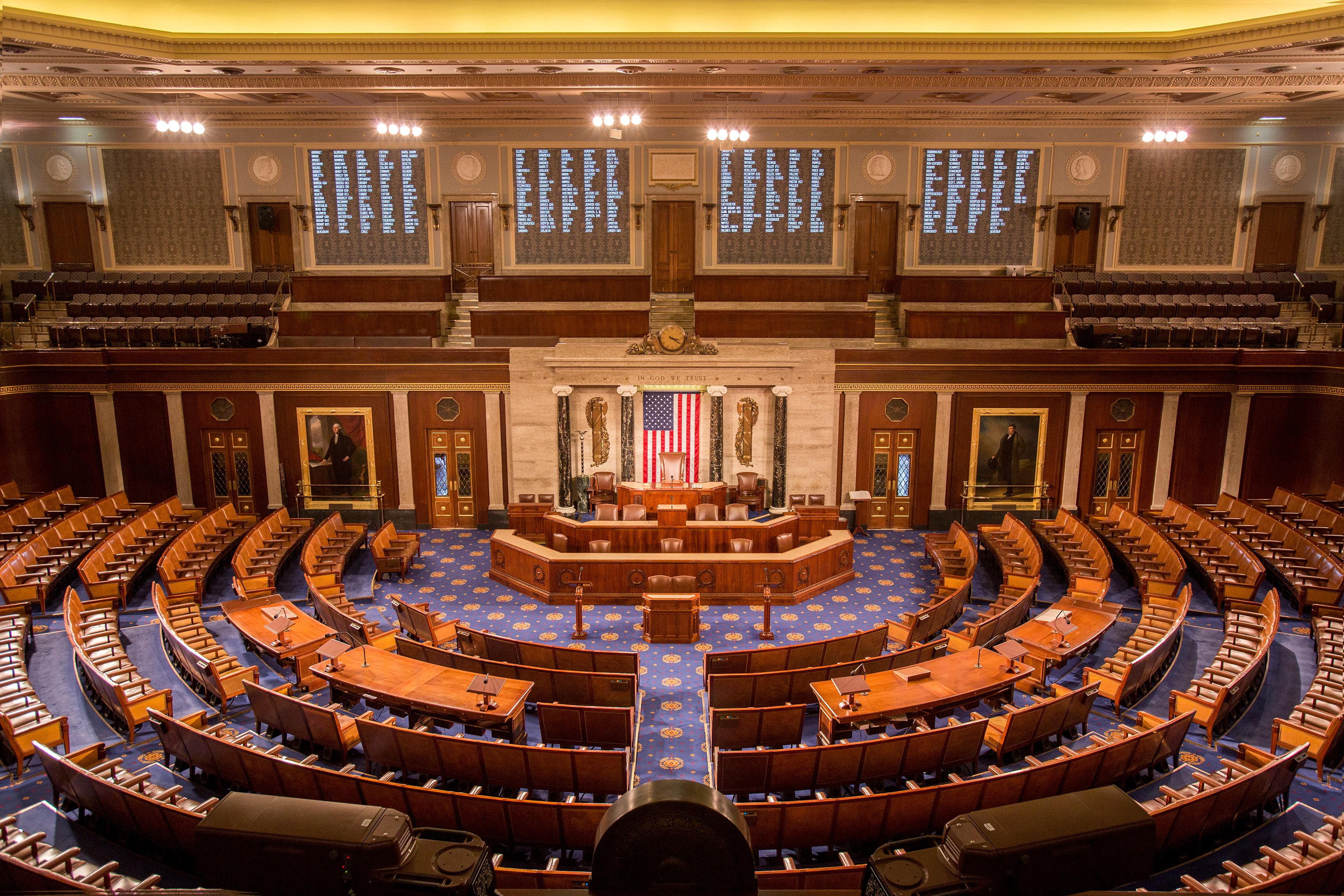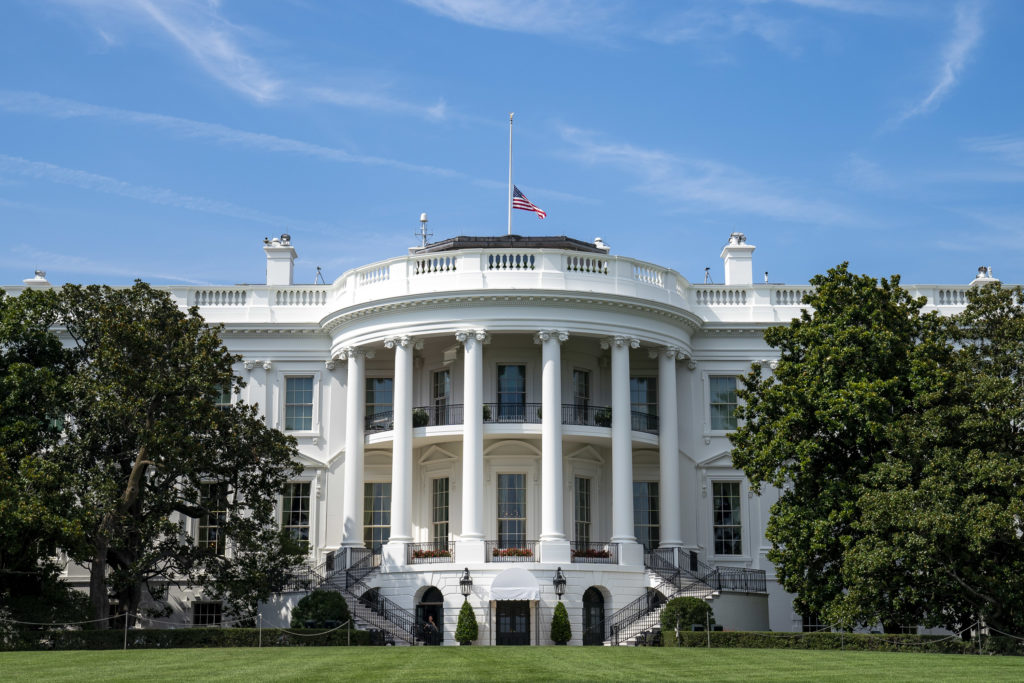Enforcement Provisions in New National Security Reforms Packages
A House bill proposes a new mechanism for judicial review of war powers. Here’s how it works.

Published by The Lawfare Institute
in Cooperation With

In the past several months, similar bipartisan reform packages have been introduced in the House and the Senate on war powers, national emergencies and arms sales. In July, Sens. Chris Murphy, Mike Lee and Bernie Sanders introduced the National Security Powers Act. In September, House Rules Chairman James McGovern, Rep. Peter Meijer and others introduced the National Security Reforms and Accountability Act (NSRAA).
These bills are the first holistic rethink of national security laws from the 1970s—namely the War Powers Resolution of 1973, the National Emergencies Act of 1976 and the Arms Export Control Act of 1976—since INS v. Chadha, the 1983 Supreme Court decision that brought a core element of those laws’ structures into constitutional doubt. Each of these laws empowered the executive branch to take certain national security actions, on the condition that Congress could press pause by passing a concurrent resolution—a measure that requires only the approval of a majority of both chambers of Congress and is not subject to a presidential veto—under expedited procedures, in what is generally called a legislative veto. But after the Chadha court suggested that legislative vetoes were most likely unconstitutional, Congress amended these statutes’ expedited legislative veto provisions to operate on the basis of joint (rather than concurrent) resolutions, which are subject to a presidential veto and would require support from two-thirds of both chambers to override such a veto if it were to occur. In effect, this severely raised the threshold of congressional support needed to countermand actions of the president, turning legislation that was designed to restrict presidential power into delegations of authority that expanded it.
The Senate’s National Security Powers Act and the House’s NSRAA are designed to reclaim the balance that Congress fleetingly struck nearly 50 years ago. Each bill adopts the same tripartite framework for addressing executive branch overreach: (a) Congress more clearly delineates the powers it is delegating to the president, (b) Congress creates special congressional procedures to ensure that the executive action is subject to timely approval by the legislature, and (c) Congress creates additional enforcement mechanisms through judicial review and explicit funding cut-offs. Each of these elements serves an important role in rebalancing powers between the branches.
This post focuses on the judicial review provisions, which are essential to making this legislation effective. These provisions address three major existing barriers to congressional vindication of the separation of powers by creating an explicit cause of action for when the executive branch fails to comply with the law, instituting a mechanism for ensuring that the House and the Senate have standing to sue and requiring expedited judicial review. These three solutions are critical to an incentive structure that will facilitate a balanced resolution of separation of powers disputes. They’re a key part of these bills, and they should be included in future legislation as well.
We explain these procedures below but first offer a brief explanation of how the war powers provisions of the NSRAA would regulate the United States’ engagement in hostilities abroad.
Overview of the War Power Provisions of the NSRAA
The NSRAA amends the War Powers Resolution of 1973 to permit the executive branch to unilaterally introduce U.S. forces into hostilities or into situations where there is a serious risk of hostilities, only in narrowly drawn circumstances. Under these amendments, the introduction of U.S. forces would begin a 20- or 30-day clock, during which Congress could enact a specific statutory authorization for the continued use of U.S. forces. If Congress does not supply the required authorization, the president would be required to remove the forces. To ensure that congressional procedural logjams do not prevent Congress from authorizing necessary military action, the NSRAA would provide expedited procedures in both the House and the Senate for a joint resolution authorizing the action.
The NSRAA includes two enforcement mechanisms inspired by the recommendations of John Hart Ely in his 1993 book, “War and Responsibility.” First, it prohibits the executive branch from spending money on any activities by U.S. forces that are not consistent with the amended War Powers Resolution and, as relevant, the aforementioned joint resolution. Second, it empowers the House and the Senate each to bring a lawsuit challenging the executive branch’s failure to comply with the act.
Judicial Review Provisions in the War Powers Title of the House’s NSRAA
Over the past 40 years, federal courts have raised barriers that keep litigants from challenging government action. These roadblocks are especially high when suits implicate presidential and/or national security actions. They are even higher when the disputes at the center of the litigation are between Congress and the president.
Courts often justify their reticence to weigh in on these interbranch disputes on the grounds that these two branches have political means of resolving them. To be sure, Congress can withhold appropriations from the executive branch and the Senate can withhold confirmation of presidential nominees in response to disfavored executive branch actions. But this policy of judicial non-intervention has not resulted in a constructive push and pull between two coordinate branches. Instead, it has allowed the executive branch—with its advantages of staffing, information and relative nimbleness—to run roughshod over Congress. (If Congress does decide to fight back, it is limited to blunt tools for doing so.) You might call this an “ask forgiveness rather than permission” decision-making structure, except that the executive branch need not ask permission or forgiveness.
In the war powers section of the House’s NSRAA, Congress directs the judiciary to step into the void and effectively enforce the separation of powers. The statute’s thoughtful design circumvents three judge-created roadblocks that often prevent courts from enforcing executive branch compliance with the law: narrow interpretations of what constitutes a cause of action, increasingly narrow standing doctrine and lengthy litigation calendars.
An Express Cause of Action Against a Comprehensive Set of Defendants
To sue, a party must have a cause of action. That is, a statute or another source of authority (such as the Constitution) must authorize the plaintiff to bring the lawsuit. While the Administrative Procedure Act (APA) provides a general cause of action for plaintiffs to challenge a wide range of agency actions, the Supreme Court has held that the APA doesn’t apply to actions taken by the president (or others at the White House), and courts are extremely hesitant to find implied causes of action in statutes. Because the War Powers Resolution of 1973 doesn’t include an express cause of action, unlawful presidential actions relating to hostilities are generally beyond judicial review.
The NSRAA would fix this by including an express cause of action for the House and the Senate, respectively, to sue any “officer or employee of the executive branch, including the President and an officer or employee of the Executive Office[] of the President,” who fails to comply with the legislation’s limits on use of force abroad. Suits for declaratory and/or injunctive relief would be brought against relevant officials in their official capacities, just as APA suits are, and would be defended by the Department of Justice. The NSRAA would also expressly permit suit by the House or the Senate where an officer or employee of the executive branch, including the president, failed “to provide any information to Congress as required” by a joint resolution authorizing the use of U.S. forces.
Standing
The only people who may use the federal judicial system to hold the government accountable for failing to comply with a statute are those who have Article III standing, generally those who are directly harmed by the government’s failure to comply with the statute.
When the president decides to effectively ignore statutes, like the War Powers Resolution, that are designed to prevent the executive branch from trampling on Congress’s Article I powers, Congress can articulate direct and concrete harm to its institutional interests. In other words, Congress may be best positioned to sue for an injunction that directs the president to comply, for example by ordering him to withdraw troops shortly after the 20-day grace period for the use of force has expired.
Designing the vehicle for such a suit is not straightforward. Because courts treat individual members of Congress as powerless absent the backing of their institution, members generally lack standing, as individuals, to challenge executive action.
For example, in a foundational 1976 case, U.S. v. AT&T, the U.S. Court of Appeals for the D.C. Circuit held that the House, which had passed a resolution authorizing the chamber’s intervention in ongoing litigation and funding outside counsel to provide representation, had standing to assert its Article I authority. The court easily distinguished the case before it (where there was standing) from one in which a single member of Congress sought to “advocate his own interest” in pursuing Article I prerogatives (where there might not be standing).
Subsequent opinions have echoed this distinction. Among them is House of Representatives v. McGahn, in which the D.C. Circuit, sitting en banc, emphasized that the Supreme Court’s legislative standing precedent holds that “individual members of a legislative body”— known as “unauthorized legislators”—“lack standing to sue the President to vindicate injuries to the legislative bodies of which they are a part” but that “lawsuit[s] brought by an authorized legislative institution asserting an institutional injury” are permissible.
Even before the 2020 McGahn opinion, judges on the U.S. District Court for the District of Columbia (where these cases typically arise) repeatedly issued similar holdings. In House of Representatives v. Burwell, for example, the district court found that the House, which had authorized the House speaker to initiate a civil action challenging the Affordable Care Act, had standing to pursue its claims that the administration had violated the Constitution by spending funds Congress did not appropriate. The holding in Burwell followed similar holdings in Committee on Judiciary v. Miers and Committee on Oversight and Government Reform v. Holder.
As in Burwell, the chamber bringing litigation under the NSRAA to challenge unlawful action by the executive branch would be vindicating its appropriations power. Section 108 of the NSRAA establishes that “no funds authorized to be appropriated or otherwise made available under any provision of law may be obligated or expended for any activity by United States forces” for which congressional authorization is not obtained consistent with the NSRAA. A failure by the executive branch to comply with the NSRAA, in other words, would amount to a nullification of each chamber’s appropriation power. And the D.C. Circuit has suggested, in its since-vacated-for-mootness opinion in House v. Mnuchin, that when the executive branch nullifies a chamber’s appropriations power, that chamber’s claim to single-chamber standing is on particularly strong footing.
Finally, courts have suggested that congressional standing can be shored up by a resolution by the relevant chamber(s) that expressly authorizes that chamber (or a representative thereof) to file the lawsuit. To this end, the NSRAA authorizes each chamber of Congress to authorize the filing of a suit on its behalf to challenge the government’s use of force and/or the government’s failure to provide certain information about that use of force. To be sure, a suit brought by both chambers would have an even stronger case for standing, but we don’t think Article III of the Constitution requires it.
Express authorization for litigation by a chamber of Congress to challenge a president’s failure to comply with a statute designed to protect Article I prerogatives should be enough to establish standing.
Three features of the NSRAA’s litigation authorization procedures, one legal and two political, are particularly notable: First, requiring the vote of a chamber of Congress to authorize litigation would enhance congressional standing, by ensuring there is express institutional authorization. Second, each chamber would be permitted to authorize litigation via a resolution that enjoys expedited procedures, which means the resolution could be brought to the floor even if House or Senate leadership opposes it. This would permit a chamber to hold the executive branch to account even when congressional leadership is opposed to doing so. Third, a vote of a chamber of Congress would itself elevate the political conflict, thereby incentivizing political solutions that the executive branch currently has insufficient reason to pursue.
As this legislation winds its way through Congress, and even if it is signed into law by the president, the executive branch may argue that Congress cannot empower itself to sue the president or other executive branch officials for failing to comply with the NSRAA. We expect that in making this argument, they will place heavy emphasis on a 2019 Supreme Court opinion, Virginia House of Delegates v. Bethune-Hill. In Bethune-Hill, the Supreme Court found that the Virginia House of Delegates “lacks authority to displace Virginia’s attorney General as representative of the State” in litigation and that “the House, as a single chamber of a bicameral legislature, has no standing to appeal the invalidation of the redistricting plan separately from the State of which it is a part.” This case is best read as limited to the peculiar nature of Virginia’s statutes, which delegate authority to litigate to the state attorney general (and not to the House of Delegates). In contrast, the NSRAA would expressly empower “a single chamber of a bicameral legislature” to bring suit.
While we anticipate constitutional challenges to the judicial review procedures in these bills, we are confident they will stand up in court as consistent with Article III of the Constitution.
Expedited Review
Judicial enforcement of executive branch lawbreaking is often hamstrung by the slow pace of litigation. To prevent the executive branch from filibustering the enforcement of statutory law, the NSRAA imposes a 30-day deadline on district court review of a congressional suit and bypasses circuit review for direct review by the Supreme Court. A 10-day deadline for the filing of an appeal will further expedite review of such cases. Courts are directed “to advance on the docket and to expedite to the greatest possible extent the disposition of the action and appeal.” Because of the gravity of the issue and because there will be no circuit court review, cases at the district court will be heard by three-judge panels, in accordance with 28 U.S.C. § 2284.
Three-judge court and expedited judicial review procedures are routine in other contexts and raise no constitutional concerns. Appellate review procedures and timelines are creatures of statute, and the structure that is today seen as standard (one district court judge, three circuit court judges and nine Supreme Court justices) has been modified frequently throughout history. Well-worn examples include certain agency review cases, where review begins at the circuit court level, and redistricting and voting rights cases, where review begins with a three-judge panel (at least one of whom is a circuit court judge), pursuant to 28 U.S.C. § 2284. Multiple statutes already call for expedited Supreme Court review of certain matters. For example, there is expedited review of litigation challenging the constitutionality of employment protections that apply to Congress and the White House.
Those who fear judicial overreach and judicial politicization (concerns that don’t easily map onto political divides) will express reservations about this approach. To them, empowering the courts to referee disputes between Congress and the executive branch may seem like a step backward from an idealized system of checks and balances in which Congress and the executive branch work out their disagreements amongst themselves. We disagree. The current incentive structure dissuades the executive branch from engaging in meaningful interbranch negotiation. Updating that incentive structure, with tools ranging from appropriations cut-offs to judicial review provisions, will bring the U.S. closer to the type of interbranch dispute resolution that many observers see as ideal.
Areas for Improvement
We have identified two areas for improvement in the NSRAA judicial review provisions. Both arise from the possibility that the relevant institutions could be polarized either in favor of or in opposition to the sitting president.
The first area for improvement concerns who and how the litigation is managed. The second concerns the composition of the three-judge panel that first handles the litigation.
Who Manages the Litigation?
According to the text of the NSRAA, the House and the Senate would be represented by the Office of the General Counsel of the House of Representatives and the Office of the Senate Legal Counsel, respectively. While those offices serve the body, the heads of those offices are in effect political appointments by the speaker of the House and the Senate majority leader.
The expedited congressional procedures in the NSRAA are designed to circumvent opposition from the speaker and/or majority leader when they are opposed to Congress directly confronting the executive on war powers issues. However, the judicial review procedures of the NSRAA could create a situation in which the person in charge of the litigation is reporting to someone who voted against initiating the litigation.
To make the challenge clear, consider what happened during the 116th Congress (2019-2020). The Senate, on a bipartisan basis, passed two joint resolutions under the War Powers Resolutions condemning actions by President Trump, with the expedited procedures in the 1973 resolution forcing floor votes. In both cases, Senate Majority Leader Mitch McConnell was on the losing side of the Senate votes. If the NSRAA had been in place, his appointee would then have been managing the high-profile litigation against the Trump administration.
The first option for managing this potential conflict is to provide that when the speaker or majority leader opposes the vote authorizing litigation, special funds are appropriated for someone else to manage the litigation. The most natural option might be the author of the resolution that authorizes the litigation. There is a genuine possibility, especially in the House, that a rank-and-file member may not have the resources to select counsel and manage the litigation. That said, this sort of confrontation with the president would likely result in either the majority or the minority in one chamber investing in the success of that litigation as a political messaging tool, in addition to a legal one. Staffing and legal expertise would likely become available to the senator or representative leading the litigation beyond those in the individual’s personal office. This would be our recommendation as the simplest alternative, even if an imperfect one, to the current structure.
Another option would be to offer a succession of chairs and ranking members who could manage the litigation as long as they are in the majority on the vote authorizing the litigation. One such line of succession would be the chair of the Senate Foreign Relations Committee (or House Foreign Affairs Committee), followed by the ranking member, followed by the chair of the Armed Services Committee, followed by the ranking member, and so on, through a series of relevant committees.
Of course, unless the chamber vote was evenly divided, the leader could change positions in order to maintain control over the litigation.
The current text—which keeps the litigation in the hands of the leadership-appointed counsel—is a reasonable approach, although we believe that the bill could be improved by having the author of the legislation manage the litigation if leadership opposes pursuing it. In any case, this dilemma illustrates that these provisions are simultaneously a political and a legal process.
Addressing Polarization in the Courts
Under the NSRAA, challenges to the executive branch’s compliance with the act would be heard initially by a three-judge panel, as set out in 28 U.S.C. § 2284(1). In accordance with that section, which governs, among other things, voting rights litigation, the composition of the panel would be selected by the chief judge of the D.C. Circuit.
Section 2284(1) was designed for a time when the judiciary was not as polarized along strictly partisan lines. To prevent a partisan chief judge from dictating an outcome by selecting like-minded partisans to hear the case, we recommend supplementing the reference to section 2284 with language outlining that, notwithstanding the text of section 2284(1), the panel shall be composed of three judges selected at random—two from the D.C. Circuit and one from the District of D.C.
Where Else Could These Enforcement Provisions Be Used?
There are several other areas where Congress has designed provisions similar to the NSRAA’s to help resolve disputes between Congress and the executive branch over the legality of executive branch action. Two examples are congressional subpoena enforcement and the Insurrection Act.
Congressional Subpoena Compliance
In 2017, Rep. Darrell Issa introduced the Congressional Subpoena Compliance and Enforcement Act after a series of bruising battles at the end of the Obama administration. This bill was reintroduced by Rep. Madeleine Dean in 2019 in response to Democratic frustration with Trump’s subpoena compliance and is part of the Protecting Our Democracy Act. This bill would have used a similar three-judge panel with expedited review in the Supreme Court to resolve subpoena fights more quickly.
Insurrection Act Reform
In 2020, Sen. Richard Blumenthal introduced the CIVIL Act (Curtailing Insurrection Act Violations of Individuals’ Liberties Act), which included several provisions similar to the war powers section of the NSRAA. These included sunsets of the underlying executive action, expedited congressional procedures and expedited judicial procedures to challenge any violations.
***
In 1973, Congress responded to executive branch overreach by creating a carefully constructed framework for ensuring congressional approval of military forays abroad. The fallout from the Supreme Court’s 1983 Chadha decision left the president with a permission structure that turned the original framework on its head. It is past time that this upside-down framework be updated with one that vindicates Congress’s constitutional interest in when and how the nation engages in hostilities abroad.
Enhanced congressional responsibility over the use of forces abroad requires robust enforcement capacity. The approach advanced in the NSRAA significantly improves on the untenable status quo by facilitating judicial review and offering a structured escalation of political conflict. The NSRAA provides a carefully constructed approach to asserting congressional authority in the realm of war powers and national security—one that provides a launch point for Congress to explore additional ways of adding teeth to its powers.






